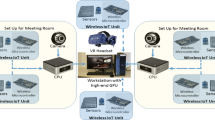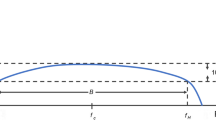Abstract
Indoor subarea localization can facilitate numerous location-based services, such as indoor navigation, indoor POI recommendation and mobile advertising. Most existing subarea localization approaches suffer from two bottlenecks, one is fingerprint-based methods require time-consuming site survey and another is triangulation-based methods are lack of scalability. In this paper, we propose a graph-based method for indoor subarea localization with zero-configuration. Zero-configuration means the proposed method can be directly employed in indoor environment without time-consuming site survey or pre-installing additional infrastructure. To accomplish this, we first utilize two unexploited characteristics of WiFi radio signal strength to generate logical floor graph and then formulate the problem of constructing fingerprint map as a graph isomorphism problem between logical floor graph and physical floor graph. In online localization phase, a Bayesian-based approach is utilized to estimate the unknown subarea. The proposed method has been implemented in a real-world shopping mall, and extensive experimental results show that the proposed method can achieve competitive performance comparing with existing methods.














Similar content being viewed by others
References
Ahmed ZU, Ghingold M, Dahari Z (2007) Malaysian shopping mall behavior: an exploratory study. Asia Pacific J Mark Logist 19(4):331–348
Angermann M, Frassl M, Doniec M, Julian BJ , Robertson P (2012) Characterization of the indoor magnetic field for applications in localization and mapping. In: 2012 international conference on indoor positioning and indoor navigation (IPIN). IEEE, pp 1–9
Azini AS, Kamarudin MR, Jusoh M (2015) Transparent antenna for WiFi application: RSSI and throughput performances at ism 2.4 GHZ. Telecommun Syst 61:1–9
Belkin M, Niyogi P (2001) Laplacian eigenmaps and spectral techniques for embedding and clustering. NIPS 14:585–591
Biehl JT, Cooper M, Filby G, Kratz S (2014) Loco: a ready-to-deploy framework for efficient room localization using wi-fi. In: Proceedings of the 2014 ACM international joint conference on pervasive and ubiquitous computing. ACM, pp 183–187
Castelli N, Stevens G, Jakobi T, Ogonowski C (2014) Placing information at home: using room context in domestic design. In: Proceedings of the 2014 ACM international joint conference on pervasive and ubiquitous computing: adjunct publication. ACM, pp 919–922
De Francisco R (2010) Indoor channel measurements and models at 2.4 GHZ in a hospital. In: Global telecommunications conference (GLOBECOM 2010), 2010 IEEE. IEEE, pp 1–6
Gao Y, Niu J, Zhou R, Xing G (2013) Zifind: exploiting cross-technology interference signatures for energy-efficient indoor localization. In: INFOCOM, 2013 Proceedings IEEE. IEEE, pp 2940–2948
Gassen M, Fhom HS (2016) Towards privacy-preserving mobile location analytics. In: Proceedings of the workshops of the EDBT/ICDT 2016 joint conference, EDBT/ICDT workshops 2016, Bordeaux, France, March 15, 2016
Hida K, Bin C, Hada Y, Mori S (2014) Evaluation of area detection method using machine learning. In: Multimedia, distributed, cooperative, and mobile symposium
Hossain AKMM, Soh W-S (2010) Cramer-rao bound analysis of localization using signal strength difference as location fingerprint. In: INFOCOM, 2010 Proceedings IEEE. IEEE, pp 1–9
Hotta S, Hada Y, Yaginuma Y (2012) A robust room-level localization method based on transition probability for indoor environments. In: 2012 international conference on indoor positioning and indoor navigation (IPIN). IEEE, pp 1–8
Hou Y, Xue Y, Chen C, Xiao S (2015) A rss/aoa based indoor positioning system with a single led lamp. In: 2015 international conference on wireless communications and signal processing (WCSP). IEEE, pp 1–4
Jiang Y, Xiang Y, Pan X, Li K, Lv Q, Dick RP, Shang L, Hannigan M (2013) Hallway based automatic indoor floorplan construction using room fingerprints. In: Proceedings of the 2013 ACM international joint conference on Pervasive and ubiquitous computing. ACM, pp 315–324
Kehagias A, Hollinger G, Singh S (2009) A graph search algorithm for indoor pursuit/evasion. Math Comput Model 50(9):1305–1317
Kim EY, Kim Y-K (2005) The effects of ethnicity and gender on teens’ mall shopping motivations. Cloth Text Res J 23(2):65–77
Komar C, Ersoy C (2004) Location tracking and location based service using ieee 802.11 wlan infrastructure. In: European wireless. Citeseer, pp 24–27
Leitinger E, Fröhle M, Meissner PL, Witrisal K (2014) Multipath-assisted maximum-likelihood indoor positioning using uwb signals. In: 2014 IEEE international conference on communications workshops (ICC). IEEE, pp 170–175
Lymberopoulos D, Liu J, Yang X, Choudhury RR, Sen S, Handziski V (2015) Microsoft indoor localization competition: experiences and lessons learned. GetMobile Mobile Comput Commun 18(4):24–31
Martin P, Ho B-J, Grupen N, Munoz S, Srivastava M (2014) An ibeacon primer for indoor localization: demo abstract. In: Proceedings of the 1st ACM conference on embedded systems for energy-efficient buildings. ACM, pp 190–191
Niu J, Wang B, Cheng L, Rodrigues JJPC (2015) Wicloc: an indoor localization system based on wifi fingerprints and crowdsourcing. In: 2015 IEEE international conference on communications (ICC). IEEE, pp 3008–3013
Pang S, Trujillo R (2013) Indoor localization using ultrasonic time difference of arrival. In: Southeastcon, 2013 Proceedings of IEEE. IEEE, pp 1–6
Peltonen E, Lagerspetz E, Nurmi P, Tarkoma S (2015) Energy modeling of system settings: a crowdsourced approach. In: 2015 IEEE international conference on pervasive computing and communications (PerCom). IEEE, pp 37–45
Rallapalli Sati, Ganesan A, Chintalapudi K, Padmanabhan VN, Qiu L (2014) Enabling physical analytics in retail stores using smart glasses. In: Proceedings of the 20th annual international conference on mobile computing and networking. ACM, pp 115–126
Ranjan J, Whitehouse K (2015) Object hallmarks: identifying object users using wearable wrist sensors. In: Proceedings of the 2015 ACM international joint conference on pervasive and ubiquitous computing. ACM, pp 51–61
Rappaport TS et al (1996) Wireless communications: principles and practice, vol 2. Prentice Hall PTR, New Jersey
Rashidi P, Mihailidis A (2013) A survey on ambient-assisted living tools for older adults. IEEE J Biomed Health Inform 17(3):579–590
Santoso F, Redmond SJ (2015) Indoor location-aware medical systems for smart homecare and telehealth monitoring: state-of-the-art. Physiol Meas 36(10):R53
She J, Crowcroft J, Fu H, Li F (2014) Convergence of interactive displays with smart mobile devices for effective advertising: a survey. ACM Trans Multimed Comput Commun Appl (TOMM) 10(2):17
Shin H, Chon Y, Kim Y, Cha H (2015) A participatory service platform for indoor location-based services. Pervasive Comput IEEE 14(1):62–69
Ullmann JR (1976) An algorithm for subgraph isomorphism. J ACM 23(1):31–42
Wagner S, Wagner D (2007) Comparing clusterings: an overview. Universität Karlsruhe, Fakultät für Informatik Karlsruhe
Wu C, Zheng Y, Yunhao L, Wei X (2013) Will: Wireless indoor localization without site survey. IEEE Trans Parallel Distrib Syst 24(4):839–848
Xiong J, Sundaresan K, Jamieson K (2015) Tonetrack: leveraging frequency-agile radios for time-based indoor wireless localization. In: Proceedings of the 21st annual international conference on mobile computing and networking. ACM, pp 537–549
Yao D, Yu C, Dey AK, Koehler C, Min G, Yang LT, Jin H (2014) Energy efficient indoor tracking on smartphones. Future Gener Comput Syst 39:44–54
Zheng Z, Chen Y, Chen S, Sun L, Chen D (2016) Bigloc: a two-stage positioning method for large indoor space. Int J Distrib Sens Netw 2016:1289013
Zheng Z, Chen Y, He T, Li F, Chen D (2015) Weight-rss: a calibration-free and robust method for wlan-based indoor positioning. Int J Distrib Sens Netw 2015:55
Zheng Z, Chen Y, He T, Sun L, Chen D (2015) Feature learning for fingerprint-based positioning in indoor environment. Int J Distrib Sens Netw 2015:180
Zhou S, Wang B, Mo Y, Deng X, Yang LT (2013) Indoor location search based on subarea fingerprinting and curve fitting. In: 2013 IEEE 10th international conference on high performance computing and communications and 2013 IEEE international conference on embedded and ubiquitous computing (HPCC_EUC). IEEE, pp 2258–2262
Acknowledgements
This work is sponsored by the National Basic Research 973 Program of China (No. 2015CB352403), the National Natural Science Foundation of China (NSFC) (61261160502, 61272099), the Program for National Natural Science Foundation of China/Research Grants Council (NSFC/RGC)(612191030), the Program for Changjiang Scholars and Innovative Research Team in University (IRT1158, PCSIRT), the Scientific Innovation Act of STCSM (13511504200), and EU FP7 CLIMBER Project (PIRSES-GA-2012-318939).
Author information
Authors and Affiliations
Corresponding author
Rights and permissions
About this article
Cite this article
Chen, Y., Guo, M., Shen, J. et al. GraphLoc: a graph-based method for indoor subarea localization with zero-configuration. Pers Ubiquit Comput 21, 489–505 (2017). https://doi.org/10.1007/s00779-017-1011-7
Received:
Accepted:
Published:
Issue Date:
DOI: https://doi.org/10.1007/s00779-017-1011-7




